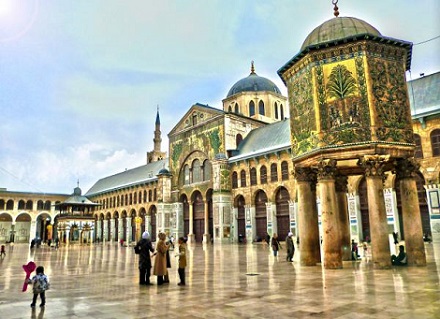The Rule of the Umayyad dynasty lasted less than one hundred years of time 661-750AD, during which the capital of the Islamic empire moved from alMadina, in the Arabian Peninsula to Damascus, an event had its influence on civilization, arts, architecture and on Arab and Islamic social and economical life. If we stand in front of some of the monuments and buildings built in that era, like the Umayyad Mosque in Damascus, and the Grand Mosque of Aleppo, Dome of the Rock in Jerusalem and the Umayyad palaces in the Syrian Desert and recognize their general appearance, beautiful architectural elements and their ornamentations, we will find ourselves in front of a special style in terms of planning, symmetry, sculpture and themes expressed in decorations.
Private factors and characteristics
Many factors participated in defining characteristics of the Arab Umayyad arts; of these factors we can mention three:
-The spiritual factor: this is represented in the ideologies, thoughts and culture introduced by Islam which refined Arab morality and matched with the spirit of the era, and with the methods of life resulting from interaction between different cultures living on Syrian land. -The practical element: This factor is reflected by the new building materials with which Syrian monuments were built, by the new nature and accumulated cultural heritage of pre Islamic periods, and by the consecutive civilizations which prospered on this land and played a prominent role in imitating, redeveloping and modifying styles of building. We can add to that the experienced Syrian labor force which had inherited artistic elements from previous generations.
– The creative factor: like developing mosques, schools, khans and palaces. The expansion of the Umayyad Empire created new needs which were not common before that period. To satisfy these needs new means of development and creativity were imperative.
During the Umayyad period mosques started departing simplicity step by step until they find their culmination in the Mosque of Dome of the Rock in Jerusalem built by Caliph Abdulamalik Ibn Marwan, and The Umayyad Mosque in Damascus built by alWalid Ibn Abdulmalik, both of them are considered source of pride of the Umayyad era in particular and the Arab Islamic civilization in general. It is important here to remember some of the mosques which were built in this era to have an idea of the development of mosque’s architecture.
During the rule of alWalid Ibn Abdumalik the mosque of alFastat, Mosque of the Prophet in alMadina were renewed and the last one had new five arcades parallel to the direction of the South (Qibla), towards which worshippers turn faces. The mosque of alQirawan was rebuilt and a square minaret was added to it during the rule of Caliph Hisham Ibn Abdulmalik.
During the rule of Suleiman Ibn Abdulmalik the Garnd Mosque of Aleppo was built along the style of the Umayyad Mosque of Damascus. Other mosques were built in Busra, Dara’a and Hama. The Mosque of Cordova in Andalusia is considered a source of pride of all the Islamic Umayyad monuments in the world.
Civil Architecture
The Umayyads built palaces outside cities and in the Syrian Desert whose remains are still erect till these days. From studies made about these palaces we had a clear idea about their importance, engineering, schemas, architecture and ornamentations applied in them mainly reliefs, frescoes and mosaics.
The relics of these palaces presented to us evident elements of unequal high artistic taste, and about the relation of the Umayyads with the Syrian Desert, because they used to live in these palaces in spring and in autumn, to breathe the fresh cool air of the desert, to hunt and to entertain themselves with open air sports. These activities were represented by the wall paintings and frescoes like hunting scenes, music and dance parties, banquets…etc, which are still in good shape in some of them. Most important of these palaces are the Eastern and western Heer palaces and their annexes, Assis palace, Hisham’s Rasafa, alMghajjar, alMashta and Amra Palaces.
Haifaa Mafalani

